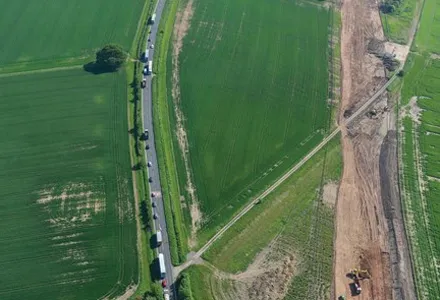A new bypass around Carlisle in North West England has opened to the public two months ahead of schedule. The Carlisle Northern Development Route (CNDR) starts from the Wigton Road (A595) to the south west of Carlisle, follows a route around the west of the city crossing the River Eden on a
new bridge near Stainton and the West Coast Main Line on a new two-lane bridge constructed at Kingmoor. The road layout allows easier access to West Cumbria from the roundabout at Junction 44 of the M6 rather than havin
May 18, 2012
Read time: 2 mins
A new bypass around Carlisle in North West England has opened to the public two months ahead of schedule.
The Carlisle Northern Development Route (CNDR) starts from the Wigton Road (A595) to the south west of Carlisle, follows a route around the west of the city crossing the River Eden on a new bridge near Stainton and the West Coast Main Line on a new two-lane bridge constructed at Kingmoor. The road layout allows easier access to West Cumbria from the roundabout at Junction 44 of the M6 rather than having to travel through Carlisle city centre providing better links to Scotland
and the North East.
The CNDR, with its combination of both building the new road and maintaining existing roads making it the first PFI (Private Finance Initiative) project of its kind for a UK local authority, was opened by Cumbria County Council (CCC) chairman John Woolley in a ribbon cutting event attended by other key county councillors and officers, contractors and local traders.
Vehicles representing local transport businesses formed a mini convoy to travel the length of the 8.25km route, which was then systematically opened in stages behind the convoy. The new road will reduce journey times through Carlisle and also cut the number of HGVs and other vehicles travelling through the city centre. Engineers will be monitoring the operation of the network and gathering data on the usage of the new road.
Major construction work on the road started in October 2009, although preliminary construction work had already began before the county council and Connect agreed their €207 million (£176 million) 30-year partnership in July 2009.
The Carlisle Northern Development Route (CNDR) starts from the Wigton Road (A595) to the south west of Carlisle, follows a route around the west of the city crossing the River Eden on a new bridge near Stainton and the West Coast Main Line on a new two-lane bridge constructed at Kingmoor. The road layout allows easier access to West Cumbria from the roundabout at Junction 44 of the M6 rather than having to travel through Carlisle city centre providing better links to Scotland
and the North East.
The CNDR, with its combination of both building the new road and maintaining existing roads making it the first PFI (Private Finance Initiative) project of its kind for a UK local authority, was opened by Cumbria County Council (CCC) chairman John Woolley in a ribbon cutting event attended by other key county councillors and officers, contractors and local traders.
Vehicles representing local transport businesses formed a mini convoy to travel the length of the 8.25km route, which was then systematically opened in stages behind the convoy. The new road will reduce journey times through Carlisle and also cut the number of HGVs and other vehicles travelling through the city centre. Engineers will be monitoring the operation of the network and gathering data on the usage of the new road.
Major construction work on the road started in October 2009, although preliminary construction work had already began before the county council and Connect agreed their €207 million (£176 million) 30-year partnership in July 2009.







